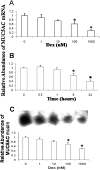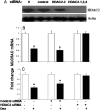Glucocorticoid receptor and histone deacetylase-2 mediate dexamethasone-induced repression of MUC5AC gene expression
- PMID: 22798432
- PMCID: PMC3547101
- DOI: 10.1165/rcmb.2012-0009OC
Glucocorticoid receptor and histone deacetylase-2 mediate dexamethasone-induced repression of MUC5AC gene expression
Abstract
Airway occlusion in obstructive airway diseases is caused in part by the overproduction of secretory mucin glycoproteins through the up-regulation of mucin (MUC) genes by inflammatory mediators. Some pharmacological agents, including the glucocorticoid dexamethasone (Dex), repress mucin concentrations in lung epithelial cancer cells. Here, we show that Dex reduces the expression of MUC5AC, a major airway mucin gene, in primary differentiated normal human bronchial epithelial (NHBE) cells in a dose-dependent and time-dependent manner, and that the Dex-induced repression is mediated by the glucocorticoid receptor (GR) and two glucocorticoid response elements (GREs) in the MUC5AC promoter. The pre-exposure of cells to RU486, a GR antagonist, and mutations in either the GRE3 or GRE5 cis-sites abolished the Dex-induced repression. Chromatin immunoprecipitation (ChIP) assays showed a rapid temporal recruitment of GR to the GRE3 and GRE5 cis-elements in the MUC5AC promoter in NHBE and in A549 cells. Immunofluorescence showed nuclear colocalization of GR and histone deacetylase-2 (HDAC2) in MUC5AC-expressing NHBE cells. ChIP also showed a rapid temporal recruitment of HDAC2 to the GRE3 and GRE5 cis-elements in the MUC5AC promoter in both cell types. The knockdown of HDAC2 by HDAC2-specific short interfering RNA prevented the Dex-induced repression of MUC5AC in NHBE and A549 cells. These data demonstrate that GR and HDAC2 are recruited to the GRE3 and GRE5 cis-sites in the MUC5AC promoter and mediate the Dex-induced cis repression of MUC5AC gene expression. A better understanding of the mechanisms whereby glucocorticoids repress MUC5AC gene expression may be useful in formulating therapeutic interventions in chronic lung diseases.
Figures







Similar articles
-
IL-1β induction of MUC5AC gene expression is mediated by CREB and NF-κB and repressed by dexamethasone.Am J Physiol Lung Cell Mol Physiol. 2014 Apr 15;306(8):L797-807. doi: 10.1152/ajplung.00347.2013. Epub 2014 Jan 31. Am J Physiol Lung Cell Mol Physiol. 2014. PMID: 24487386 Free PMC article.
-
A novel dissociative steroid VBP15 reduces MUC5AC gene expression in airway epithelial cells but lacks the GRE mediated transcriptional properties of dexamethasone.Pulm Pharmacol Ther. 2016 Jun;38:17-26. doi: 10.1016/j.pupt.2016.04.004. Epub 2016 Apr 29. Pulm Pharmacol Ther. 2016. PMID: 27133900
-
Dexamethasone-mediated repression of MUC5AC gene expression in human lung epithelial cells.Am J Respir Cell Mol Biol. 2006 Mar;34(3):338-47. doi: 10.1165/rcmb.2005-0176OC. Epub 2005 Oct 20. Am J Respir Cell Mol Biol. 2006. PMID: 16239644 Free PMC article.
-
Effects of dexamethasone on VEGF-induced MUC5AC expression in human primary bronchial epithelial cells: Implications for asthma.Exp Cell Res. 2020 Apr 15;389(2):111897. doi: 10.1016/j.yexcr.2020.111897. Epub 2020 Feb 6. Exp Cell Res. 2020. PMID: 32035951
-
Glucocorticoid receptors take part in the apoptotic process of human lens epithelial cells, but the glucocorticoid receptor antagonist RU486 does not rescue the cells fully.Mol Biosyst. 2011 Jun;7(6):1926-37. doi: 10.1039/c1mb05045a. Epub 2011 Mar 31. Mol Biosyst. 2011. PMID: 21451860
Cited by
-
Expression of cPLA2γ mRNA and protein differs the response of PBMC from severe and non-severe asthmatics to bacterial lipopolysaccharide and house dust mite allergen.Int J Immunopathol Pharmacol. 2021 Jan-Dec;35:2058738421990952. doi: 10.1177/2058738421990952. Int J Immunopathol Pharmacol. 2021. PMID: 33626953 Free PMC article.
-
Cellular and molecular biology of airway mucins.Int Rev Cell Mol Biol. 2013;303:139-202. doi: 10.1016/B978-0-12-407697-6.00004-0. Int Rev Cell Mol Biol. 2013. PMID: 23445810 Free PMC article. Review.
-
Strategies for measuring airway mucus and mucins.Respir Res. 2019 Nov 21;20(1):261. doi: 10.1186/s12931-019-1239-z. Respir Res. 2019. PMID: 31752894 Free PMC article. Review.
-
Dexamethasone Treatment Increases the Intracellular Calcium Level Through TRPV6 in A549 Cells.Int J Mol Sci. 2020 Feb 5;21(3):1050. doi: 10.3390/ijms21031050. Int J Mol Sci. 2020. PMID: 32033337 Free PMC article.
-
IL-1β induction of MUC5AC gene expression is mediated by CREB and NF-κB and repressed by dexamethasone.Am J Physiol Lung Cell Mol Physiol. 2014 Apr 15;306(8):L797-807. doi: 10.1152/ajplung.00347.2013. Epub 2014 Jan 31. Am J Physiol Lung Cell Mol Physiol. 2014. PMID: 24487386 Free PMC article.
References
-
- Rose MC. Mucins: structure, function, and role in pulmonary diseases. Am J Physiol Lung Cell Mol Physiol 1992;263:L413–L429 - PubMed
-
- Corfield AP, Shukla AK. Mucins: vital components of the mucosal defensive barrier. Genom Proteom Technol 2003;3:20–22
-
- Rogers DF. Mucoactive agents for airway mucus hypersecretory diseases. Respir Care 2007;52:1176–1193 - PubMed
-
- Hollingsworth MA, Swanson BJ. Mucins in cancer: protection and control of the cell surface. Nat Rev Cancer 2004;4:45–60 - PubMed
Publication types
MeSH terms
Substances
Grants and funding
LinkOut - more resources
Full Text Sources
Medical

